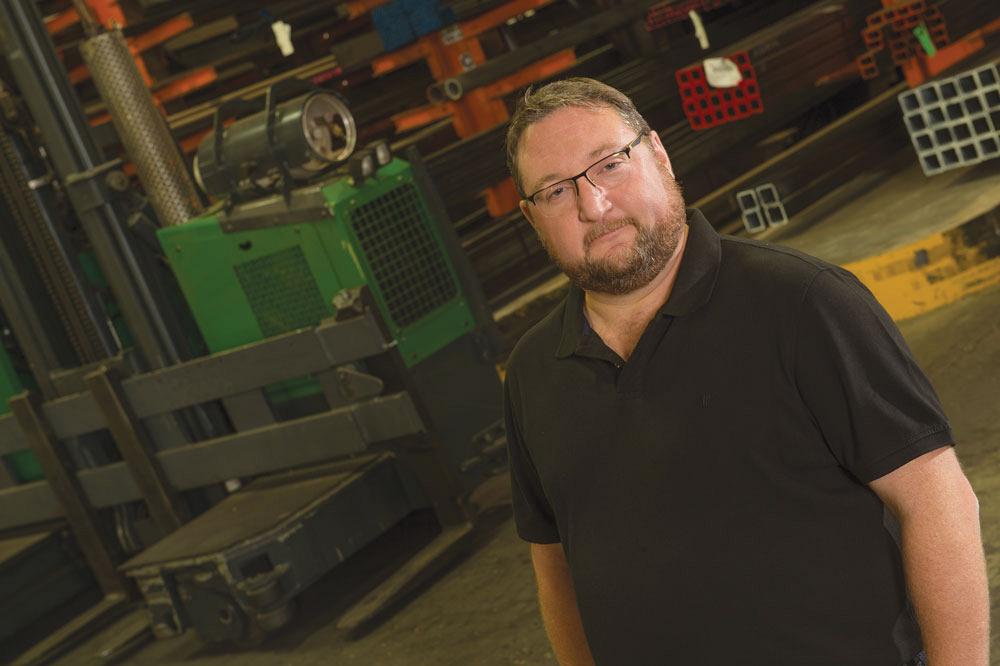Editor
- FMA
- The Fabricator
- FABTECH
- Canadian Metalworking
Process flow reimagined
Brunswick Steel redesigns its shop floor to add new equipment and efficiencies
- By Rob Colman
- October 19, 2018
- Article
- Automation and Software
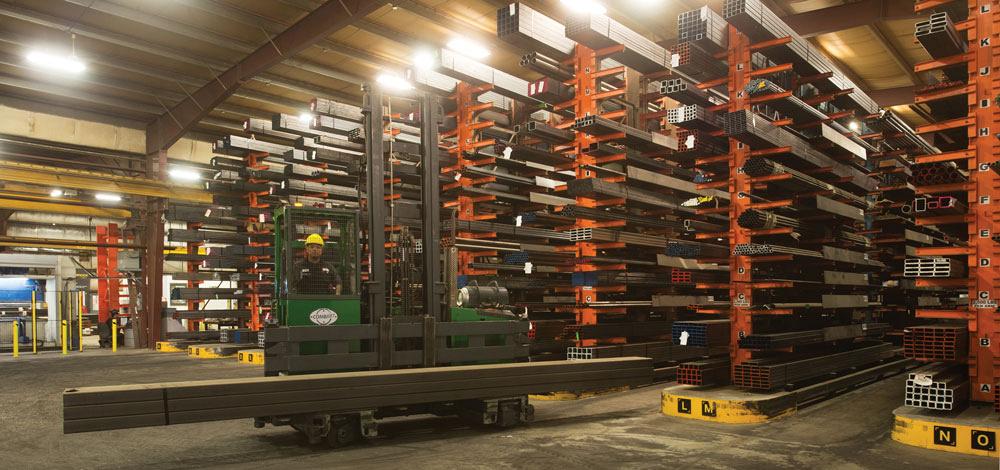
“We essentially added 50 per cent to our capacity in the building by taking that racking up to the ceiling,” said Operations Manager Adam Plouffe about the company’s cantilevered racking system for bar and angle stock. “It opened it up to a proper lay down and loading area for our lift trucks.” Photos by Walter Janzen, www.janzenphotography.com.
Efficiencies can be found in many forms – from new equipment investments to rethinking how a shop floor flows. Often, it’s a combination of the two that pays the greatest dividends. That is the experience of Winnipeg-based service centre Brunswick Steel. Between the adoption of newer fibre laser technology and the redesign of its shop floor, the company has been able to increase productivity substantially without adding much staff or expanding the shop footprint.
Metal service centres have had to adapt to market changes, like most other shops, by adding services and speeding delivery times. Brunswick Steel is no exception.
“We’ve found that in the past few years, not only have we had to compete against the larger big-box service centres, but also against sophisticated job shops in the Winnipeg area,” said Justin Copp, co-owner and general manager of Brunswick. “And in general, margins are tighter and we have to keep tighter controls on inventory.”
The business was launched by the three Copp brothers as a salvage company back in the 1970s and moved into selling new steel in the 1980s. One brother and second-generation family members Justin Copp and Christine Dockter now own the company, which processes sheet and plate steel up to 6 inches thick, alongside bar, tubing, and beam stock. The shop covers 65,000 square feet and includes 80 employees, about 55 of which work on the shop floor.
Throughout the company’s history there has always been a push for more value-added processing of the steel sold in the shop. Until recently Brunswick ran two 5-kW CO2 lasers, along with a high-definition plasma table, two multi-head oxy-fuel torch tables for processing plate up to 6 in. thick, four saws, and two press brakes.
The lasers were situated in an out-building that also housed the two press brakes. This arrangement was not ideal, but space constraints demanded it. However, when the owners decided it was time to upgrade their laser technology to a fibre machine that included a 16-shelf tower, they understood that the shop would require a redesign.
“We had already received advice from an outside consultant on improving material movement and process flow throughout the shop,” said Dockter, who serves as CFO of the company. “We are part of the North American Steel Alliance, and we found AGH Consulting through that network. The firm has designed about 300 steel centres, and they helped us determine how we wanted to reconfigure part of our facility so that our storage would go vertical and save a lot of floor space.”
Process Improvement Expertise
Although Dockter and Copp were keen to introduce changes to the shop floor to increase efficiencies, neither considers themselves experts in process improvement strategies, so they brought in new employees who did have that experience. Adam Plouffe, operations manager, was one of those hires. He came on board about two years ago and quickly came up with a variety of suggestions about how to begin realigning the shop to a lean ideal in which bottlenecks are constantly addressed and the efficiency of each process is interrogated.
“My background is in the composite industry, which is very different in many ways,” said Plouffe. “But the human dynamic is the same.”
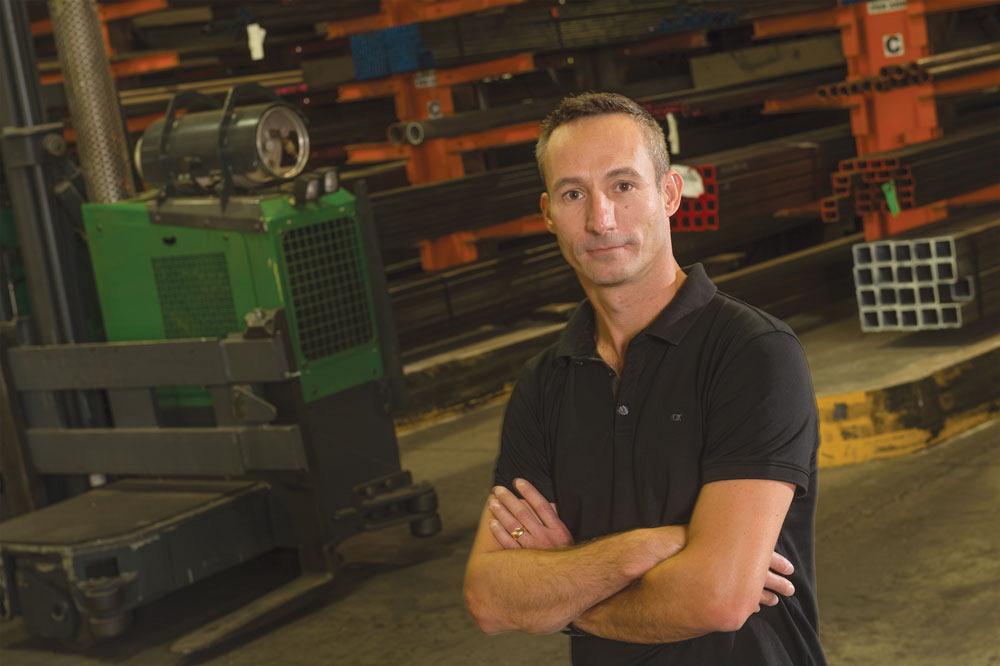
“We’ve found that in the past few years, not only have we had to compete against the larger big-box service centres, but also against sophisticated job shops in the Winnipeg area,” said Justin Copp, co-owner and general manager of Brunswick.
Plouffe has a background in lean and Six sigma training.
“When I met the Brunswick management team, I saw immediately that we had a lot of the same values,” said Plouffe. “I could see they had a real vision for the company and needed someone who could implement some of those plans.”
Walking through the plant, Plouffe could see many places where efficiencies could be found in short order.
“My focus was on the seven wastes, and a big one for us was motion―moving parts excessively around the plant for processing before heading out the door,” Plouffe said. There were also a number of personnel changes, “getting the right people in the right place,” as Plouffe put it. “We now hire for character as much as we do for skill. You can be the best machine operator in the world, but if you have a bad attitude, it just isn’t going to work.”
With the right people on-side, Plouffe was able to launch a 5S program in the shop. But he started it with a twist to boost the confidence of the team.
“Normally with a 5S program you implement each ‘S’ individually, starting with sorting,” Plouffe explained. “In this case we did a 5S blitz in our maintenance department. This tends to be the last department you do because it’s so challenging, with parts from all kinds of equipment. But I walked in the door of the maintenance department and couldn’t find anything. We did a two-week blitz, and now we have a maintenance department that shines. It also became a demonstration for the whole company. We toured all employees through the department, including salespeople who had never been in the maintenance department, so it was a good way for everyone to see how we are a team, and that we are going to pursue more projects like this.”
At the same time, management introduced regular cross-functional team meetings so that the purchasing, sales, operations, and quality departments could discuss challenges every couple of weeks.
“This was a way that we were able to improve communications inter-departmentally,” said Plouffe.
Making certain that employees felt they were being heard at all levels was another part of the team-building that Plouffe encouraged. He did so through the introduction of a “quick and easy” kaizen program.
“We created a form that allows team members to suggest simple ways in which we can improve their department,” said Plouffe. “One example of this was just moving certain tools so that they permanently resided in a particular department. In that one example we probably saved many hours in the course of a year. In fact, in the first two months of that program we did 25 quick and easy kaizens, and the cost savings that came out of those was about $85,000 annually. With each kaizen suggested and implemented, that staff member received a gift card in appreciation from the company. For a minor cost, the company sees significant gains. It also demonstrates to the team that we care about their input and we’re serious about creating meaningful change.”
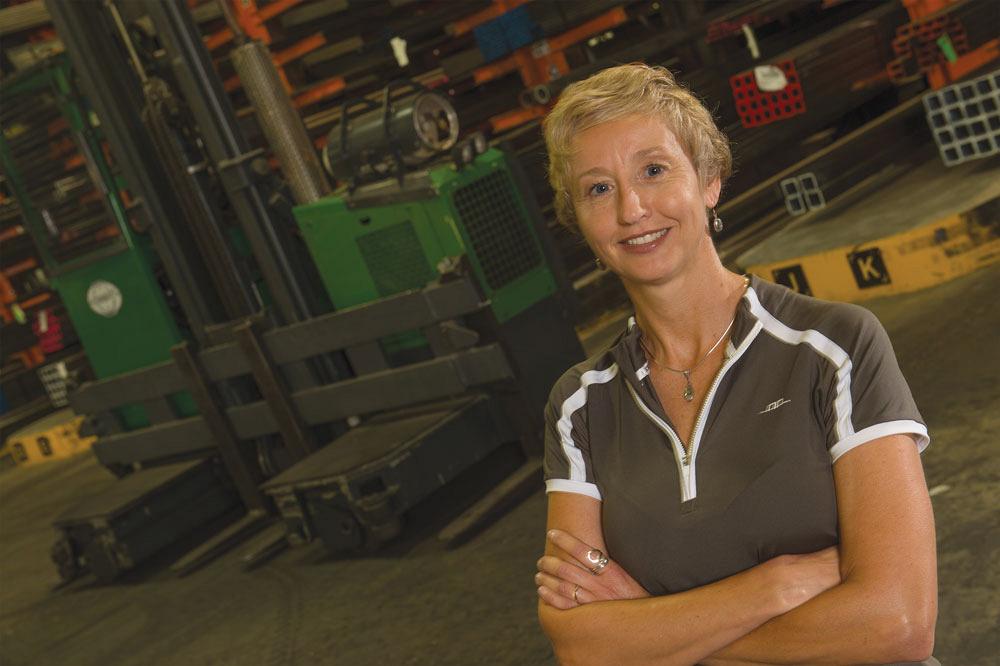
“We’re really proud of the whole organization, how our whole team has come together to make these changes possible,” said Christine Dockter, co-owner and CFO of Brunswick. “And we’re proud to be able to show the results of these changes to our customers.”
These small changes prepared the team for the necessarily more disruptive changes to come.
Reconfiguring for Efficiencies
The first big project involving the movement of heavy machinery was reconfiguring the saw department so that two saws could be operated by one operator without the need to move. Previously access to the control panels required the operator to walk around the whole department from one to the other.
“That was a small project, but it had a significant impact,” said Plouffe. “The team was getting used to project-based actions, and this helped ease them into planning for bigger efforts.”
The next big project was the introduction of cantilevered racks on one large wall for all bar and angle stock. The consultant that Brunswick had engaged helped source the racks, which have a total of 740 slots for different products, and each section holds 10,000 lbs.
“We essentially added 50 per cent to our capacity in the building by taking that racking up to the ceiling,” said Plouffe. “It opened it up to a proper lay down and loading area for our lift trucks.”
“All of that stock is now 100 per cent accessible without moving other steel out of the way,” said Copp. “It is better from a health and safety perspective as well.”
“We started seeing improvements in job throughput almost immediately when the storage system went in,” said Dockter. “It made it easier to pick orders, as all of that stock was labelled and recognized in our ERP system. There was no longer ever any need to hunt for materials.”
“Historically it might have taken us two minutes to pull one piece of material,” said Plouffe. “Now it’s about a two-and-a-half-minute cycle time to pull a full order. It was a huge win for us. We were able to be much more efficient and have gained a lot of sales in that area because we can turn jobs around a lot faster.”
Installing the racking system took between six and eight weeks and required the shop to run using about one third its usual space. But because the team had already been encouraged to embrace change, Plouffe said they really engaged in the process.
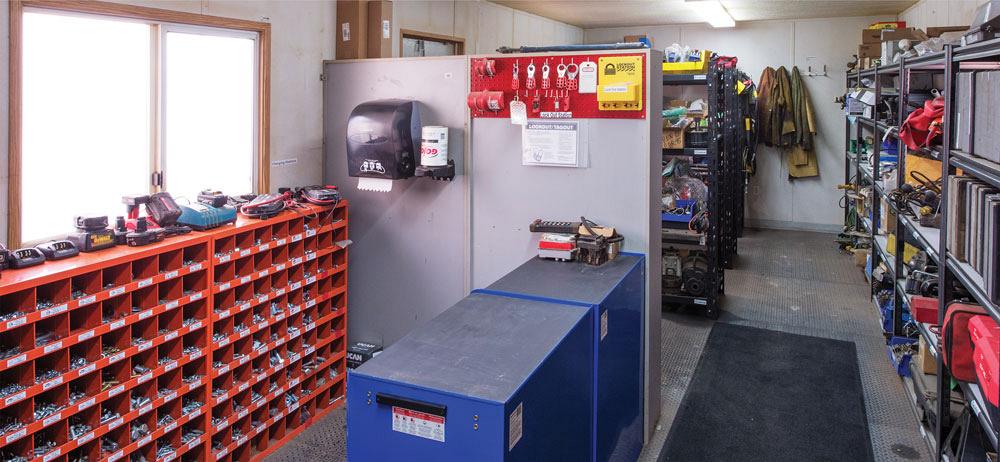
On its journey to create greater efficiencies in the shop, Brunswick first did what Plouffe describes as a “5S blitz” in the company’s maintenance department. This became a demonstration for all employees of what was possible with the 5S approach to space management and the right continuous improvement mindset.
Fibre Laser Update
In 2017 the Brunswick management team visited FABTECH® Chicago to look at fibre lasers. The company chose Mitsubishi’s 8-kW fibre laser with 16-shelf tower.
“The processing speed on the new machine is a huge change for us,” said Plouffe. “It cuts so much faster than our CO2s. It’s nothing against our other lasers either; they worked great. It’s just that the technology has come so far in the years since we purchased those.”
Where it used to take Brunswick 20 minutes to nest a sheet of material, the shop’s new system can nest a week’s worth of the same material in a fraction of the time.
“The software that came with the laser is one of the main reasons we went with this particular machine,” said Plouffe. “Our big focus in the facility has been to reduce the time to quote, the time to nest, and the time to process and get products out the door. I see myself as a rookie when it comes to metalworking equipment. At the end of the day, any new equipment we bought would have had a large impact on our production, but the software on this was so intuitive, even while we were still at the show I felt pretty confident I could get the machine running using it. The easier the software is for employees, the faster we get product out the door.”
Copp also points to the relationship that Mitsubishi has with local distributor Wallace Machinery as an advantage. “Service is so important,” he said. “If you can’t get the local support, you’ve lost any other advantages the machine gives you.”
Before bringing in the new laser, Brunswick shifted its two existing press brakes into its main building and added a new 120-ton, 10-ft. Accurpress brake. The height of the tower on the new laser required that it be placed in the main facility. With the space savings of the racking system the shop installed, enough room was freed up that this shift wasn’t an issue. Now, under one roof, part flow is both consolidated and simplified. New racking systems for sheet being fed to the laser was the last step in this process, and that was installed this summer.
Pondering Bottlenecks
On the quoting side, Brunswick installed geometric-based quoting software to speed quoting processes. The technology can take a flat part drawing in DXF or DWG format and provide a quote based on parameters it gathers from the enterprise resource planning (ERP) system and any other parameters a shop supplies, such as bend presets.
“If there’s any challenge with this, it’s that now scheduling is our bottleneck because quotes are getting through so much faster,” said Plouffe. “We are in the process of evaluating our ERP to ensure that it will provide us with real-time visual scheduling.”

The first big project involving the movement of heavy machinery was reconfiguring the saw department so that two saws could be operated by one operator without the need to move. Previously access to the control panels required the operator to walk around the whole department from one to the other.
Bottlenecks will always be there, of course. Right now, Brunswick is seeing it in its break-out and press brake areas as well.
“We knew that the speed of a fibre laser would take some getting used to, but until you experience it, the difference is hard to wrap your mind around,” said Plouffe. “We have two people in our break-out area on both shifts staying very busy. It is early days yet. We are still thinking through processes to more effectively shift cut parts.”
There’s no question that all of the changes that the company has made in the past few years are paying dividends in production gains. But it’s also a matter of pride for the whole team.
“We’re really proud of the whole organization, how our whole team has come together to make these changes possible,” said Dockter. “And we’re proud to be able to show the results of these changes to our customers.”
“At this point we’ve redesigned 80 per cent of our shop space,” said Copp. “Through the process we’ve witnessed the talent of our staff. The strong people have really risen to the occasion.”
Editor Robert Colman can be reached at rcolman@canadianfabweld.com.
Brunswick Steel, www.brunswicksteel.com
About the Author

Rob Colman
1154 Warden Avenue
Toronto, M1R 0A1 Canada
905-235-0471
Robert Colman has worked as a writer and editor for more than 25 years, covering the needs of a variety of trades. He has been dedicated to the metalworking industry for the past 13 years, serving as editor for Metalworking Production & Purchasing (MP&P) and, since January 2016, the editor of Canadian Fabricating & Welding. He graduated with a B.A. degree from McGill University and a Master’s degree from UBC.
subscribe now


Keep up to date with the latest news, events, and technology for all things metal from our pair of monthly magazines written specifically for Canadian manufacturers!
Start Your Free Subscription- Trending Articles
Class is in session for college connections
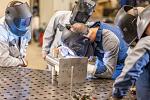
BlueForge Alliance partners with Nuts, Bolts & Thingamajigs to develop Submarine Manufacturing Camps

Portable system becomes hot tech in heat treatment

Orbital tube welding webinar to be held April 23

Cidan Machinery Metal Expo 2024 to be held in Georgia May 1-2

- Industry Events
MME Winnipeg
- April 30, 2024
- Winnipeg, ON Canada
CTMA Economic Uncertainty: Helping You Navigate Windsor Seminar
- April 30, 2024
- Windsor, ON Canada
CTMA Economic Uncertainty: Helping You Navigate Kitchener Seminar
- May 2, 2024
- Kitchener, ON Canada
Automate 2024
- May 6 - 9, 2024
- Chicago, IL
ANCA Open House
- May 7 - 8, 2024
- Wixom, MI













